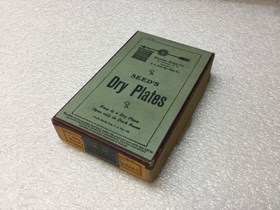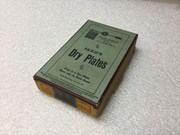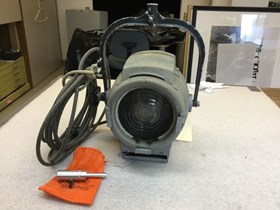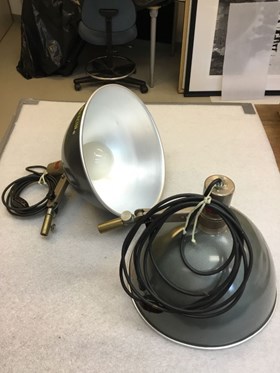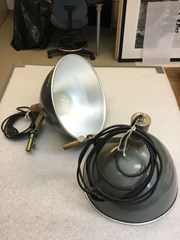Narrow Results By
- Date
- c. 1910
- Material
- leather; metal; glass; wood; plastic; textile
- Catalogue Number
- 104.41.0249
- Description
- Buster Brown box camera with brown leather handle. Solid structure with black textile covering made to resemble leather. The front of the camera has a hole that likely once held a lens. There are two smaller holes in the upper corner of the front, which contain small glass parts. There is also meta…
1 image
- Title
- Box Camera
- Date
- c. 1910
- Material
- leather; metal; glass; wood; plastic; textile
- Dimensions
- 13.5 x 9.7 x 15.9 cm
- Description
- Buster Brown box camera with brown leather handle. Solid structure with black textile covering made to resemble leather. The front of the camera has a hole that likely once held a lens. There are two smaller holes in the upper corner of the front, which contain small glass parts. There is also metal hardware holding the front exterior panel to the structure. One side has a round hole with glass held by metal hardware, creating a viewfinder. There is also a metal winding mechanism, and a lever for the shutter release. The lever activates a mechanism that quickly uncovers and then re-covers the inner lens. The rear part of the camera has a small round, red-tinted window that would have shown the number for the section of film in position. At the top is a metal hinge that can be lifted to open the back panel, which comes down and is connected with a textile hinge. The top of the camera has a leather handle attached with metal pegs. The leather handle is worn, but you can see that it has been engraved by the manufacturer with the text: “No. 2A BUSTER BROWN”. There is also a viewfinder on the front corner. When the metal latch is opened, the rear panel opens and the interior cartridge can be seen. Pulling out the handle of the winding mechanism on the side of the camera releases the cartridge so that it can be removed. It’s a wooden box with a lens on the front and it has compartments for spools that hold the film. There is a spool in one side, but the other is empty. There are also two metal rollers that would hold the film in place. One side of the wooden cartridge is engraved with the following text: “MFD. BY”; “ANSCO COMPANY”; “BINGHAMTON, N.Y.”; “U.S.A.”; “PATENTED”; “JUNE 23 1903”; “SEPT. 20 1910”; “OTHER PAT. PENDING”; “FOR 6A OR 6B FILM”. Above the engraving is some handwriting in pencil that reads “6-A”; “2 1/2 x 4 1/2”. link to pdf of user manual: http://www.cameramanuals.org/agfa_ansco/ansco_buster_brown_camera.pdf
- Credit
- Gift of Don Harmon, Banff, 1985
- Catalogue Number
- 104.41.0249
Images
This material is presented as originally created; it may contain outdated cultural descriptions and
potentially offensive content.
Read more.
- Date
- 1905 – 1927
- Material
- wood; metal; fabric
- Catalogue Number
- 104.41.0248 a-d
- Description
- A wooden tripod made by Eastman Kodak company. 3 sets of wooden legs that fold and slide out to extend - brass detailing and screw-knobs. The top of the tripod is a circular disk with brass detailing on the bottom to attach the legs, and the top of the disk has brown felt for where the camera would…
1 image
- Title
- Camera Tripod
- Date
- 1905 – 1927
- Material
- wood; metal; fabric
- Dimensions
- 112.0 x 18.0 cm
- Description
- A wooden tripod made by Eastman Kodak company. 3 sets of wooden legs that fold and slide out to extend - brass detailing and screw-knobs. The top of the tripod is a circular disk with brass detailing on the bottom to attach the legs, and the top of the disk has brown felt for where the camera would sit. Dimension for d) 3.3 x 15.4 x 15.4 cm
- Credit
- Gift of Don Harmon, Banff, 1985
- Catalogue Number
- 104.41.0248 a-d
Images
This material is presented as originally created; it may contain outdated cultural descriptions and
potentially offensive content.
Read more.
Exposure Plates
https://archives.whyte.org/en/permalink/artifact104.41.0207
- Date
- 1902 – 1920
- Material
- cardboard; paper; glass;
- Catalogue Number
- 104.41.0207
- Description
- Box of one dozen 3 1/4 x 5 1/2 glass Seed’s Dry Plates with cut paper adhesive tape around the edges and bottom and manufacturer details printed on a pale green background throughout the lid. These dry plates were invented by M.A. Seed in 1879 and became very popular with photographers as the plate…
1 image
- Title
- Exposure Plates
- Date
- 1902 – 1920
- Material
- cardboard; paper; glass;
- Dimensions
- 3.0 x 9.3 x 15.0 cm
- Description
- Box of one dozen 3 1/4 x 5 1/2 glass Seed’s Dry Plates with cut paper adhesive tape around the edges and bottom and manufacturer details printed on a pale green background throughout the lid. These dry plates were invented by M.A. Seed in 1879 and became very popular with photographers as the plates came pre-prepared with the emulsion layer already applied - prior to “dry” plates, photographers would need portable dark rooms in which they would create their liquid emulsions prior to taking a photograph [known as “wet” plates]. Seed’s dry plates still required they be opened in a dark room, but this could be accomplished in the field by placing a dark sheet over the camera while loading and unloading the plates. In 1902, Eastman Kodak purchased Seed’s company [Seed Dry Plate Co.], but continued to capitalize on his name due to its reputation among consumers.
- Credit
- Gift of Robert Crosby Family, Banff, 1998
- Catalogue Number
- 104.41.0207
Images
This material is presented as originally created; it may contain outdated cultural descriptions and
potentially offensive content.
Read more.
- Date
- 1940 – 1960
- Material
- metal; glass; plastic; fabric;
- Catalogue Number
- 102.05.0115
- Description
- Dull grey metal flood/spotlight used in studio settings for film-making or photography. The main body of the light is shaped like a small barrel - one end has a carved crystal bordered in thick cord and the other has a door that opens by pushing a small button in order to access the light bulb insi…
1 image
- Title
- Flood Light
- Date
- 1940 – 1960
- Material
- metal; glass; plastic; fabric;
- Dimensions
- 42.0 x 28.0 x 31.0 cm
- Description
- Dull grey metal flood/spotlight used in studio settings for film-making or photography. The main body of the light is shaped like a small barrel - one end has a carved crystal bordered in thick cord and the other has a door that opens by pushing a small button in order to access the light bulb inside. The centre of the door features the Bardwell & McAlister Inc. logo. The barrel also has housing attached to the top and bottom - one contains a lever that, when pushed from side to side, moves the light bulb inside closer to or further from the crystal. Attached to the front on either side of the crystal are brackets where a filter can be fit; a Y-shaped support can be rotated 180 degrees and is adjusted by a handle on one side; an on/off switch sits in a raised metal bracket on one side, and near the switch the power cord feeds out of the barrel - the cord is wrapped in grey fabric and is coiled up and attached to the support with a short length of rope. Attached to the power cord is an orange fabric bag with a wire drawstring that contains a silver metal cylinder that could possibly be an attachment for the support.
- Credit
- Gift of Nicholas Morant, Banff, 2006
- Catalogue Number
- 102.05.0115
Images
This material is presented as originally created; it may contain outdated cultural descriptions and
potentially offensive content.
Read more.
- Date
- 1940 – 1960
- Material
- metal; glass; plastic;
- Catalogue Number
- 102.05.0116
- Description
- Dull grey metal flood/spotlight used in studio settings for film-making or photography. The main body of the light is shaped like a small barrel - one end has a carved crystal bordered in thick cord and the other has a door that opens by pushing a small button in order to access the light bulb insi…
1 image
- Title
- Flood Light
- Date
- 1940 – 1960
- Material
- metal; glass; plastic;
- Dimensions
- 42.0 x 28.0 x 31.0 cm
- Description
- Dull grey metal flood/spotlight used in studio settings for film-making or photography. The main body of the light is shaped like a small barrel - one end has a carved crystal bordered in thick cord and the other has a door that opens by pushing a small button in order to access the light bulb inside. The centre of the door features the Bardwell & McAlister Inc. logo. The barrel also has housing attached to the top and bottom - one contains a lever that, when pushed from side to side, moves the light bulb inside closer to or further from the crystal. Attached to the front on either side of the crystal are brackets where a filter can be fit; a Y-shaped support can be rotated 180 degrees and is adjusted by a handle on one side; an on/off switch sits in a raised metal bracket on one side, and near the switch the black plastic power cord feeds out of the barrel - the cord is coiled up and attached to the support with a short length of rope.
- Credit
- Gift of Nicholas Morant, Banff, 2006
- Catalogue Number
- 102.05.0116
Images
This material is presented as originally created; it may contain outdated cultural descriptions and
potentially offensive content.
Read more.
Folding Camera
https://archives.whyte.org/en/permalink/artifact104.41.0245
- Date
- 1905 – 1927
- Material
- metal; leather; glass; wood
- Catalogue Number
- 104.41.0245
- Description
- A large, black leather bound square folding camera from Eastman Kodak Co. The camera when folded looks like a leather case with a leather handle attached at the top with two large metal buttons. One of the shorter sides features varying mechanisms to make adjustments to the camera. At the top is re…
1 image
- Title
- Folding Camera
- Date
- 1905 – 1927
- Material
- metal; leather; glass; wood
- Dimensions
- 24.6 x 23.0 x 10.0 cm
- Description
- A large, black leather bound square folding camera from Eastman Kodak Co. The camera when folded looks like a leather case with a leather handle attached at the top with two large metal buttons. One of the shorter sides features varying mechanisms to make adjustments to the camera. At the top is rectangular shaped metal plate with a knob that can be twisted and will make a clicking noise with a engraved arrowed to indicate turn the knob counter-clockwise, underneath is a l-shaped leaver that has a minor turn radius with an “M” engraved on the one arm. In the middle is a gold metal knob that can be pushed away from the case to open the one side and reveal the camera. Near the knob is a metal plate that reads “SPEED GRAPHIC CURTAIN APERTURE”, a graph with numbers, and “FOLMER & SCHWING DIVISION” “EASTMAN KODAK CO.” “13476 ROCHESTER, N.Y.” At the bottom is another square-shaped plate with a knob that can be turned that corresponds to numbers in a small black circle in the plate. On the top of the case is a white sticker with blue numbers “68622”. On the back of the case is a section for film holders/double dark slides and a glass plate behind a piece of the case that opens with a clasp at the bottom of the square. The other short side features small metal circles and a hole for a screw - most likely for a tripod mount. The front of the case is flat. When the case is opened it reveals the folded camera with black bellows and a silver metal face with a Wollensak Betax No.3 lens. It moves on a track to extend and retract with a mechanism in the front that when pinch together allows for the movement of the camera. There is a partially ripped sticker on the wood panel that reads “Sales - Service - Repairs” “Camera & Instrument Crafts” “9452 Calgary, Alta.” One side of the panel also features a black plate with numbers for focal range.
- Credit
- Gift of Don Harmon, Banff, 1985
- Catalogue Number
- 104.41.0245
Images
This material is presented as originally created; it may contain outdated cultural descriptions and
potentially offensive content.
Read more.
Folding Camera
https://archives.whyte.org/en/permalink/artifact104.41.0250
- Date
- c. 1947
- Material
- metal; plastic; glass; leather;
- Catalogue Number
- 104.41.0250
- Description
- A black and silver folding Graflex Crown Graphic camera. The exterior of the camera, on either short side features a silver mount for flashes and shutter release button, which is a rectangle button, (left side) and black leather strap handle (right side). On the back of the camera is a section for …
1 image
- Title
- Folding Camera
- Date
- c. 1947
- Material
- metal; plastic; glass; leather;
- Dimensions
- 21.4 x 19.0 x 10.0 cm
- Description
- A black and silver folding Graflex Crown Graphic camera. The exterior of the camera, on either short side features a silver mount for flashes and shutter release button, which is a rectangle button, (left side) and black leather strap handle (right side). On the back of the camera is a section for the cut film, released by two metal latches, as well as a ground glass back hidden under the folding viewfinder [letting the user know exactly how the image will appear on the film] and releases with a small metal clasp. Towards the top of the back is a metal arm with a black plastic circle at the top that can be slid up as a circular peep finder with various focal ranges on it. On the top of the camera is two other view finders mounted, which are positioned on the right side of the camera, on the left side is a red button. In front of the mount is a raised button (covered in the leather finish) near the the smaller viewfinder, this triggers the camera to open revealing the camera lens. When open the lens is mounted on rails that slides forward and back with soft black leather bellows. It is moved forward by twisting a metal arm with a circle on top in the middle of the lens, this also locks the lens into place on the track. There are two different sets of knobs on either of the lens which allow the lens to lift up and tilt, and with a metal arm at the front of the lens to use for these movements. The metal knobs on the front panel move the inner track that the lens is attached to to move forward and backwards. Along this track is a focal range meter (right side). The front of the camera lens mount reads “Crown [in cursive] GRAPHIC”. The actual lens is missing.
- Subject
- film photography
- photography
- Graflex
- Harmon
- camera
- Credit
- Gift of Don Harmon, Banff, 1985
- Catalogue Number
- 104.41.0250
Images
This material is presented as originally created; it may contain outdated cultural descriptions and
potentially offensive content.
Read more.
Folding Camera
https://archives.whyte.org/en/permalink/artifact104.41.0280
- Date
- c. 1910
- Material
- wood; metal; leather
- Catalogue Number
- 104.41.0280
- Description
- A small black box folding camera. On the top of the camera is a set of two hinged latches which open the back panel of the camera (the leather is separating from the camera). There is also a bump on the top of the camera that when pressed releases the front panel of the camera that reveals the fold…
1 image
- Title
- Folding Camera
- Date
- c. 1910
- Material
- wood; metal; leather
- Dimensions
- 11.5 x 8.0 cm
- Description
- A small black box folding camera. On the top of the camera is a set of two hinged latches which open the back panel of the camera (the leather is separating from the camera). There is also a bump on the top of the camera that when pressed releases the front panel of the camera that reveals the folding lens, tracks, and a viewfinder near the top of the panel. There is no lens, and the silver metal lens holder is separated from the red bellows. On the other side of the front panel is a hole which a tripod can be screwed into. There are also two small holes on either side of the camera near the top, possibly for a strap.
- Credit
- Gift of Catharine Robb Whyte, O. C., Banff, 1979
- Catalogue Number
- 104.41.0280
Images
This material is presented as originally created; it may contain outdated cultural descriptions and
potentially offensive content.
Read more.
Folding Camera
https://archives.whyte.org/en/permalink/artifact104.41.0281
- Date
- 1906 – 1916
- Material
- wood; metal; leather
- Catalogue Number
- 104.41.0281
- Description
- A medium-sized black box folding camera. The top of the camera features a leather handle stamped with “PREMO” in the middle attached with two silver clasps, a circular black and red sticker with white text that reads “FILM” “THE” “PREMO” “CAMERA” “NO.1”, a set of two silver metal latches that open …
1 image
- Title
- Folding Camera
- Date
- 1906 – 1916
- Material
- wood; metal; leather
- Dimensions
- 16.0 x 12.1 cm
- Description
- A medium-sized black box folding camera. The top of the camera features a leather handle stamped with “PREMO” in the middle attached with two silver clasps, a circular black and red sticker with white text that reads “FILM” “THE” “PREMO” “CAMERA” “NO.1”, a set of two silver metal latches that open the back panel, and a small bump that opens the front panel of the camera. The back panel features a metal plate stamped with “U.S.A. PAT. NOV.10-03.” Once opened the back panel reveals the backside of the bellows and lens. On the interior of the panel the name “Bud Miller” is etched in, stamped text that reads “MANUFACTURED BY” “EASTMAN KODAK CO.” “SUCCESSORS TO” “ROCHESTER OPTICAL CO.” “ROCHESTER, N.Y. U.S.A.” “NO.” “1” “PREMO FILM”, etched “6257”, “PAT. JULY 8-1902” “NOV. 10-1903”. There is a black sticker with gold text that reads “The Kodak House” “BISHOP & CHRISTIE” “VANCOUVER, B.C.” When the front panel is released the lens, red leather bellows, focal range meter, and viewfinder. To extend the lens outwards, there are two silver latches that are pinched together. On the lens there is a shutter speed adjustment at the top, “T” “B” “I”, and along the bottom is an aperture adjustment “128” “64” “32” “16” “8” “4”, above the aperture range is text that reads “Eastman Kodak Co. Succ’rs to” “ROCHESTER OPTICAL CO.”. The viewfinder can be shifted from portrait to landscape.
- Credit
- Gift of Catharine Robb Whyte, O. C., Banff, 1979
- Catalogue Number
- 104.41.0281
Images
This material is presented as originally created; it may contain outdated cultural descriptions and
potentially offensive content.
Read more.
- Date
- 1940 – 1960
- Material
- metal; glass; plastic; fabric;
- Catalogue Number
- 102.05.0122 a,b
- Description
- Two large round floodlights most likely used in studio settings. Each light consists of a large grey metal dome from the back of which extends a brown metal support that includes the power cord and a base to fit into a stand. A sticker with the manufacturer’s details is stuck to the supports. The p…
1 image
- Title
- Spot Light
- Date
- 1940 – 1960
- Material
- metal; glass; plastic; fabric;
- Description
- Two large round floodlights most likely used in studio settings. Each light consists of a large grey metal dome from the back of which extends a brown metal support that includes the power cord and a base to fit into a stand. A sticker with the manufacturer’s details is stuck to the supports. The power cords are standard black rubber cords with a plastic-cased switch fit into them, coiled in loops and held in place by short lengths of white rope. Both lights still have large opaque white light bulbs in them.
- Credit
- Gift of Nicholas Morant, Banff, 2006
- Catalogue Number
- 102.05.0122 a,b
Images
This material is presented as originally created; it may contain outdated cultural descriptions and
potentially offensive content.
Read more.





